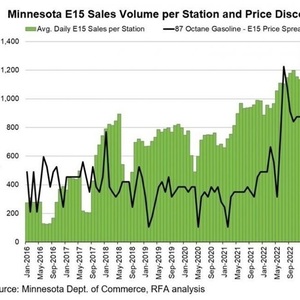RFA: Minnesota E15 volume hits record

February 20, 2023
BY Renewable Fuels Association
Sales of E15, a gasoline blend containing 15 percent ethanol, hit a record 171 million gallons in Minnesota in 2022, according to a new Renewable Fuels Association analysis of data from the Minnesota Department of Commerce.
This represented a 31 percent increase over the prior year due to a combination of more stations offering E15, ethanol’s cost-competitiveness, and steps taken by the Biden administration to avoid obsolete restrictions on summertime E15 sales nationally. However, this progress is at risk unless the administration moves quickly to allow the blend to be sold in Minnesota and other Midwest states this summer.
Advertisement
Advertisement
The Minnesota sales data confirm previous analyses of U.S. demand for E15 last summer. RFA estimated that American consumers saved $57 million due to Environmental Protection Agency waivers allowing E15 to be sold between June 1 and September 15 in conventional gasoline areas, at a time when retail gasoline prices hit a record high. Additionally, the U.S. Energy Information Administration determined, “Last summer, when the price of fuel ethanol was lower than the petroleum component of gasoline, record amounts of ethanol were blended into the gasoline sold in the United States.” EIA specifically noted, “Ethanol's large discount to gasoline drove higher fuel ethanol blend rates, such as E15 … and E85 … which were more attractive to consumers who wanted to take advantage of lower prices.”
However, sales will be severely limited this coming summer unless the EPA takes action soon, due to a 2021 D.C. Circuit Court ruling in favor of oil refiners that vacated a rule allowing E15 to meet the same vapor pressure standard as the ubiquitous E10 blend. In April 2022, eight Midwest state governors notified EPA of their intent to opt out of the 1-pound vapor pressure waiver that is provided to E10, thereby creating a level playing field for E10 and E15. Governors of two other states subsequently issued similar requests. Yet, despite a statutory requirement for EPA to issue regulations implementing the governors’ petitions within 90 days of receipt, the agency still has not responded.
Advertisement
Advertisement
“We are pleased that consumers in Minnesota opted to purchase record volumes of lower-priced, lower-carbon E15 last year,” said RFA President and CEO Geoff Cooper. “However, the clock is ticking for the EPA to take the action required to allow E15 to be sold in Minnesota and other Midwest states this summer. The EPA is obligated to issue regulations immediately in response to the governors’ petitions, and the administration should put its full weight behind finding a permanent solution to allow E15 to be sold year-round nationally, such as supporting the Consumer and Fuel Retailer Choice Act.”
Related Stories
The U.S. Energy Information Administration maintained its forecast for 2025 and 2026 biodiesel, renewable diesel and sustainable aviation fuel (SAF) production in its latest Short-Term Energy Outlook, released July 8.
XCF Global Inc. on July 10 shared its strategic plan to invest close to $1 billion in developing a network of SAF production facilities, expanding its U.S. footprint, and advancing its international growth strategy.
U.S. fuel ethanol capacity fell slightly in April, while biodiesel and renewable diesel capacity held steady, according to data released by the U.S. EIA on June 30. Feedstock consumption was down when compared to the previous month.
XCF Global Inc. on July 8 provided a production update on its flagship New Rise Reno facility, underscoring that the plant has successfully produced SAF, renewable diesel, and renewable naphtha during its initial ramp-up.
The U.S. exported 31,160.5 metric tons of biodiesel and biodiesel blends of B30 and greater in May, according to data released by the USDA Foreign Agricultural Service on July 3. Biodiesel imports were 2,226.2 metric tons for the month.
Upcoming Events










